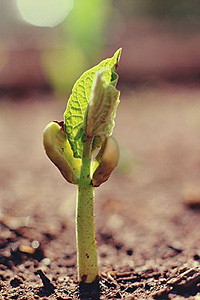 |
 |
 |
 Editorials | Opinions | December 2007 Editorials | Opinions | December 2007  
Worldwatch Perspective: Rebuilding Food Security
 Jessica Hanson - The New Nation Jessica Hanson - The New Nation
go to original


| | In the wake of disaster, rebuilding food production and distribution to help people gain access to safe and nutritious food without fear of hunger or starvation is the essence of food security. |
As scientists continue to debate the connection between climate change and natural disasters, 2007 has been an active year for extreme weather. Latin America and the Caribbean have experienced multiple natural disasters in recent months, affecting key economic sectors including food and cash crop production.

From drought-ruined potato crops in Bolivia to the ravages of Hurricane Felix in Honduras and Guatemala, large-scale disasters often disrupt, if not destroy, food security, particularly for the poor. According to Ali Gurkan, head of the Food Outlook programme of the United Nations Food and Agriculture Organization (FAO), "Any unforeseen flood or crisis can make prices rise very quickly. I do not think we should panic but we should be very careful about what may happen."

Consider the region of Tabasco, home to Mexico's largest cacao crop as well as sugarcane and banana production. Devastating flooding in recent weeks has severely disrupted agricultural output, causing more than US$700 million in damages, according to the Mexican Insurance Industry Association. Although the disaster has not had international consequences for food prices since the crops were mainly for domestic consumption, the region's ability to produce safe and nutritious food for the Mexican market has been greatly compromised. An official with the Tabasco Economic Ministry went so far as to state that, "One hundred percent of all the crops and agricultural fields have been lost because of flooding," driving up prices nationwide and destroying the livelihoods of the one-third of Tabasco residents that work in ranching and agriculture.

This begs the question: how can Mexico and other developing nations protect domestic food security in the wake of disaster? In response to the Tabasco flooding, the UN's World Food Programme (WFP) has delivered 100 metric tons of ready-to-eat High Energy Biscuits (HEBs) to the affected area, and as of November 6, the U.S. Agency for International Development had pledged $300,000 in emergency relief. But more than short-term food aid is needed.

Disasters not only reduce short-term domestic food supplies, they pose a major risk to future production. The Sri Lankan fishing industry, for example, is still struggling to recover from the December 2004 Indian Ocean tsunami, which affected 1,300 kilometers of coastline and damaged or destroyed 75 percent of the country's fishing fleet. A compromised fisheries sector continues to be a large challenge to re-establishing post-tsunami food security in Sri Lanka and other countries where the deadly waves hit. The FAO (with assistance from Italy) is helping Sri Lanka's agricultural, forestry, and fisheries sectors over the medium and long term by providing new equipment and assistance in improving labor standards. Between May 2005 and August 2007, this program was able to help 39,800 people reconstruct their livelihoods and improve the nation's food security.

In the wake of disaster, rebuilding food production and distribution to help people gain access to safe and nutritious food without fear of hunger or starvation is the essence of food security. It is a goal for which there are no easy answers, yet one that must be achieved. This sentiment was recently reiterated by WFP Executive Director Josette Sheeran, who noted that, "we must help people protect themselves and their families. It's a large order but with the support of the international community we can do it-we must do it."

Jessica Hanson, a food and agriculture intern at the Worldwatch Institute, recently completed her M.A. in International Relations at the University of Sussex, where she wrote her dissertation on global food issues. | 
 | |
 |



